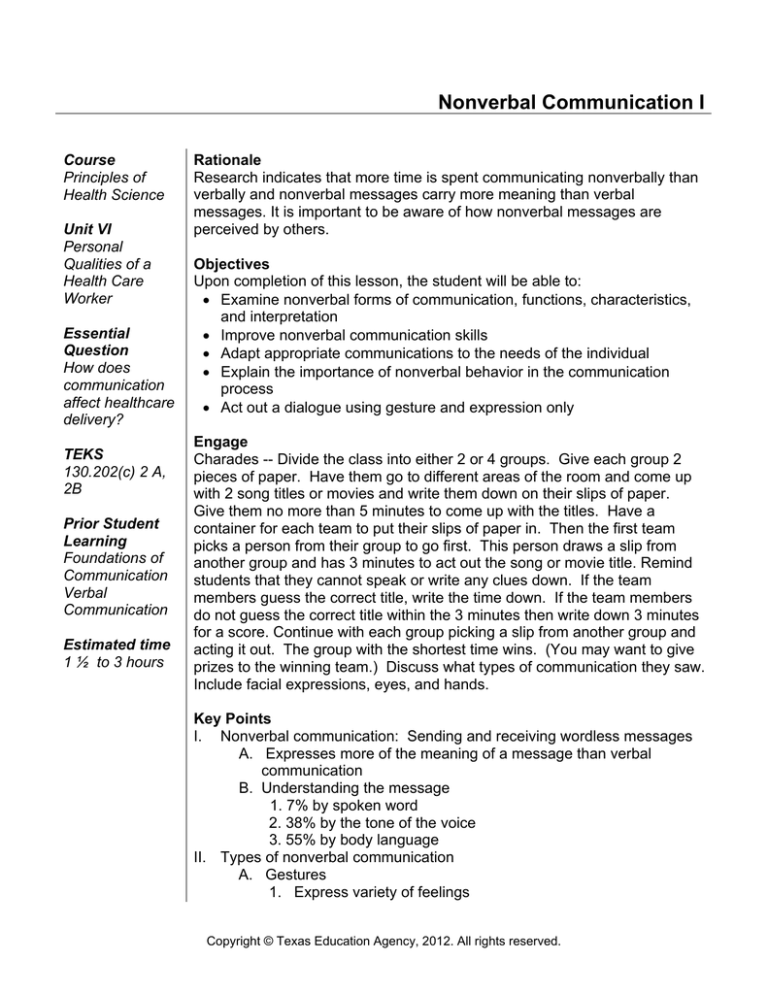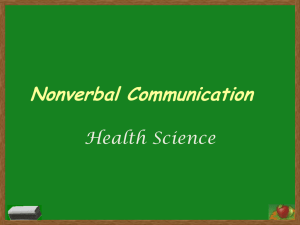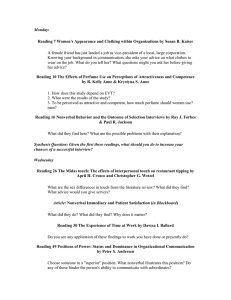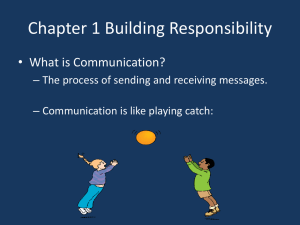Nonverbal Communication I
advertisement

Nonverbal Communication I Course Principles of Health Science Unit VI Personal Qualities of a Health Care Worker Essential Question How does communication affect healthcare delivery? TEKS 130.202(c) 2 A, 2B Prior Student Learning Foundations of Communication Verbal Communication Estimated time 1 ½ to 3 hours Rationale Research indicates that more time is spent communicating nonverbally than verbally and nonverbal messages carry more meaning than verbal messages. It is important to be aware of how nonverbal messages are perceived by others. Objectives Upon completion of this lesson, the student will be able to: Examine nonverbal forms of communication, functions, characteristics, and interpretation Improve nonverbal communication skills Adapt appropriate communications to the needs of the individual Explain the importance of nonverbal behavior in the communication process Act out a dialogue using gesture and expression only Engage Charades -- Divide the class into either 2 or 4 groups. Give each group 2 pieces of paper. Have them go to different areas of the room and come up with 2 song titles or movies and write them down on their slips of paper. Give them no more than 5 minutes to come up with the titles. Have a container for each team to put their slips of paper in. Then the first team picks a person from their group to go first. This person draws a slip from another group and has 3 minutes to act out the song or movie title. Remind students that they cannot speak or write any clues down. If the team members guess the correct title, write the time down. If the team members do not guess the correct title within the 3 minutes then write down 3 minutes for a score. Continue with each group picking a slip from another group and acting it out. The group with the shortest time wins. (You may want to give prizes to the winning team.) Discuss what types of communication they saw. Include facial expressions, eyes, and hands. Key Points I. Nonverbal communication: Sending and receiving wordless messages A. Expresses more of the meaning of a message than verbal communication B. Understanding the message 1. 7% by spoken word 2. 38% by the tone of the voice 3. 55% by body language II. Types of nonverbal communication A. Gestures 1. Express variety of feelings Copyright © Texas Education Agency, 2012. All rights reserved. a. contempt b. hostility c. approval d. affection 2. Can be used in addition to words 3. Differ by culture B. Body Language and Posture 1. unconscious barrier between you and the receiver - crossing arms 2. sign of disbelief - scratching the chin 3. good health and positive attitude – shown by erect posture fatigue -slumped posture 4. angry - clenched fist 5. anxiety - clearing the throat 6. assertiveness - pointing finger 7. boredom - leaning on one's elbow with the chin in the hand 8. boredom - wiggling a foot 9. concealing something - no eye contact 10. defiant - hands on hips 11. dominance - sitting backwards on a chair 12. doubtful - touching ear 13. everything under control - thumbs in belt or pants 14. expectation - rubbing palms 15. feeling superior - hands behind one's back 16. guilt - lowering the eyes 17. honesty - open palms occasionally touching the chest 18. impatience - tapping or drumming fingers 19. insecurity - biting fingernails 20. interest in someone or something - tilted head 21. lack of confidence - failing to look someone in the eyes 22. lying - touching face 23. making a decision - stroking chin 24. needs reassurance - hand to throat 25. nervous - fiddling with items 26. readiness - standing with hands on hips 27. rejecting what is being said - rubbing nose 28. unconcerned - leg swung over chair 29. unwilling - arms crossed tightly across chest C. Facial Expressions 1. Most expressive part of the body 2. 7 universally accepted emotions shown a. fear b. anger c. surprise d. contempt e. disgust Copyright © Texas Education Agency, 2012. All rights reserved. f. happiness g. sadness D. Eye Contact 1. Often initiates communication 2. Good contact means respect, a willingness to listen, and to keep communication open 3. Looking away means anxiety, defenselessness, or avoidance of communication 4. Cultural Differences a. some view eye contact as an invasion of privacy b. eye contact considered disrespectful E. Object Communication such as clothing and hairstyles 1. Healthy people with good self-esteem pay attention to dress and grooming 2. People feeling ill show much less interest in appearance and dress 3. Health Care Workers a. Uniforms clean, neat and well fitting b. If uniforms not required, clothing should be clean, neat and appropriate to the area e.g. jeans may be allowed in recreation therapy but not in a nursing area or an office F. Touch 1. Multiple meanings a. positive messages: provide affirmation, provide reassurance, share warmth, approval and emotional support b. negative messages: anger, frustration, punishment, invasion of personal space 2. Health care worker needs to weigh the benefits against the negatives when using touch Activity I. Complete the Nonverbal Communication Activity. II. Complete the Decoding Body Language Worksheet. Assessment Writing Rubric Key - Decoding Body Language Worksheet Materials Charades: Pieces of paper or 3 x 5 cards for each group to write their song titles or movie titles; 2-4 containers to hold the finished title slips; and a timer or watch to time the groups. Accommodations for Learning Differences Copyright © Texas Education Agency, 2012. All rights reserved. For reinforcement, students will role play emotions that express nonverbal communication (fear, anger, pain). For enrichment, student will develop a video of nonverbal communication scenarios to be evaluated by class. National and State Education Standards National Health Science Standards HLCO2.01 Communications Health Care Workers will know the various methods of giving and obtaining information. They will communicate effectively, both orally and in writing. Adjust communication to other’s ability to understand. Apply the elements of communication using the sender-receiver model. Apply active listening skills using reflection restatement and clarification techniques. Demonstrate courtesy to others including self introduction. Interpret verbal and nonverbal behaviors to augment communication within the scope of practice. TEKS 130.202(c)(2)A identify components of effective and non-effective communication; and 130.202(c)(2)B demonstrate effective communication skills for responding to the needs of individuals in a diverse society. Texas College and Career Readiness Standards English Language Arts II B Understand new vocabulary and concepts and use them accurately in reading, speaking and writing III A Understand elements of communication both in informal group discussions and formal presentations B Develop effective speaking styles for both group and one on one situations IV A Apply listening skills as an individual and as a member of a group in a variety of settings B Listen effectively in informal and formal situations Cross Disciplinary Standards I Key Cognitive Skills B Writing across the curriculum C Problem Solving 1. Analyze a situation to identify a problem to be solved 2. Develop and apply multiple strategies to solve a problem 3. Collect evidence and data systematically, directly related to solving a problem E Work habits 1. Work Independently 2. Work Collaborative Copyright © Texas Education Agency, 2012. All rights reserved. Nonverbal Communication Activity In pairs communicate the following messages using only nonverbal communication. a. b. c. d. e. f. g. h. i. j. I’m thirsty I have a pain in my stomach. It’s too hot in here. Can I have another pain reliever? I would like to go to sleep now. My back tooth is sensitive to cold. My knee is swollen. I want to go home. It’s too noisy in here. Can you help me get to the chair? Write a paragraph about what this exercise taught you about the importance of nonverbal communication. Write a paragraph about how this might influence your practice in a health care field. Copyright © Texas Education Agency, 2012. All rights reserved. Decoding Body Language DIRECTIONS: Match the following items. 1. ______ angry 2. ______ assertiveness 3. ______ boredom 4. ______ concealing something 5. ______ defiant 6. ______ doubtful 7. ______ everything under control 8. ______ feeling superior 9. ______ guilt 10. ______ honesty 11. ______ insecurity 12. ______interest in someone or something 13. ______ lack of confidence 14. ______ lying 15. ______ making a decision 16. ______ nervous 17. ______ readiness 18. ______ unconcerned a. b. c. d. e. f. g. h. i. j. k. l. m. n. o. p. q. r. lowering the eyes pointing finger standing with hands on hips thumbs in belt or pants touching face no eye contact touching ear failing to look someone in the eyes leg swung over chair tilted head clenched fist wiggling a foot hands behind one's back open palms occasionally touching the chest fiddling with items stroking chin biting fingernails hands on hips Copyright © Texas Education Agency, 2012. All rights reserved. Decoding Body Language KEY DIRECTIONS: Match the following items. 1. ___k___ angry 2. ___b___ assertiveness 3. ___l___ boredom 4. ___f___ concealing something 5. ___r___ defiant 6. ___g___ doubtful 7. ___d___ everything under control 8. ___m___ feeling superior 9. ___a___ guilt 10. ___n___ honesty 11. ___q___ insecurity 12. ___j___ interest in someone or something 13. ___h___ lack of confidence 14. ___e___ lying 15. ___p___ making a decision 16. ___o___ nervous 17. ___c___ readiness 18. ___i___ unconcerned a. b. c. d. e. f. g. h. i. j. k. l. m. n. o. p. q. r. lowering the eyes pointing finger standing with hands on hips thumbs in belt or pants touching face no eye contact touching ear failing to look someone in the eyes leg swung over chair tilted head clenched fist wiggling a foot hands behind one's back open palms occasionally touching the chest fiddling with items stroking chin biting fingernails hands on hips Copyright © Texas Education Agency, 2012. All rights reserved. Writing Rubric Student: ________________________________ Date: ___________________ Scoring criteria 4. 3. Excellent Good 2. Needs 1. Needs Some Much N/A Improvement Improvement The writing has all required parts from introduction to conclusion in smooth transition. The writing is interesting, supportive, and complete. The writing demonstrates that the writer comprehends the writing process. Accurate spelling, grammar, punctuation. Content of paragraphs emphasizes appropriate points. The writer shows an understanding of sentence structure, paragraphing, and punctuation. All sources and references are clearly and accurately documented. NOTE: N/A represents a response to the performance which is "not appropriate." Copyright © Texas Education Agency, 2012. All rights reserved.






